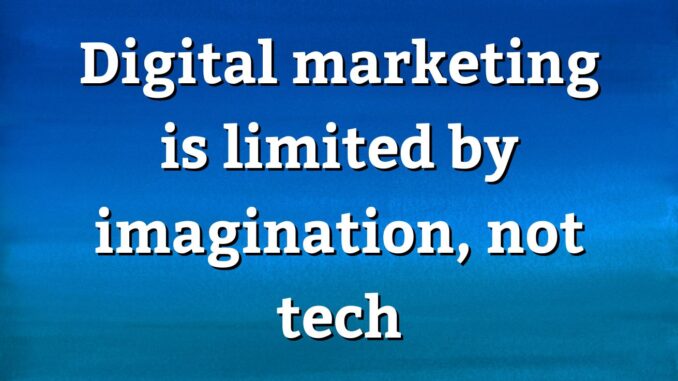
Digital marketing is limited by imagination, not tech
This is not another article about ChatGPT or AI and how it’s changing the face of business, says Jacques Du Bruyn, managing director at Flume. Du Bruyn adds that technology, particularly in the digital marketing space, is limited by us as users rather than its capacity or capability.
That means that AI can help us do what we do, better — but it’s not going to revolutionise any industry in terms of doing things in new ways.
The evolution of marketing
A while back, Kotler’s ‘Four Ps’ (Product, Price, Place and Promotion) was the gospel. Then things evolved and we moved on to the ‘Four Cs’ (Customer, Cost, Convenience and Communication).
This was before entering the stage of Integrated Marketing Communications (IMC) and onwards to social media, digital marketing, influencers and AI — with each new phase adopted more quickly than the last, due to the speed at which the world started to move.
ChatGPT v1.0 was released in November 2022 and we’re already on v4.0 in the space of six months. Marketing and the tech we are able to employ are evolving almost faster than we can keep up.
Understanding how to deploy tech means knowing what the essence of digital marketing is. What it isn’t, is a web banner, a social media post, a YouTube video or a landing page. Creating templates on Canva makes you creative, not a marketer. Digital marketing is looking at all the available digital technology, understanding it and then utilising it to solve marketing’s number one aim: solving a business problem.
The tech sits between the problem statement and the solution. It’s the ‘what if?’, which we don’t ask enough, that can help us solve that problem.
Solving the business problem
What does that application look like in practice? Let’s say we’re designing a chatbot. It can answer questions if the question and the answer appear in the FAQ from which it draws its knowledge. Now if you take a look at ChatGPT and pull it into the API to use a Large Language Model (LLM), you can use that to drive UX, rather than a landing page or improve the user experience by having a conversation, not trying to match prompts.
Another example is taking tech a step further — retailers can already use CCTV cameras to develop heatmaps that show where, when and how people shop. What if we deployed that tech to understand how we could target ads to people walking through a shopping centre; to maximise the time they spend in the store or gain insights into their behaviour and allow us to better target them for e-commerce instead?
I recently updated a policy with a financial services provider and had to use an app to analyse my face. The tech behind the app asked if I was stressed, how old I was and a few other questions to build a profile about me. This was to inform the way the changes were made to the policy.
What if we deployed that tech in digital marketing to understand people’s moods by scanning their faces and were able to market to them based on emotion, rather than action?
Information is changing
You can also use AI, or you can use AI right. We’ve all created plenty of hypothetical client personas for presentations as a ‘best guess’ of who it is we’re speaking to and how they will react.
Now we can use platforms like delve.ai to delve into the analytics and history of a site and have it create personas based on genuine information — giving us insights into the psychographics and demographics of the audience in seconds.
Stable Diffusion has just launched a model which relies on thoughts, rather than text prompts, to generate videos. You can literally think of a video and the platform will build it for you. Is the world of digital marketing ready for that?
People are finding information in new ways — using new platforms — which means how they interact online is changing. SEO is changing, digital content is changing and education is changing — and the way people interact with businesses is changing.
If AI is able to generate instant, meaningful responses more quickly than a salesperson, why wouldn’t a customer want to speak to the bot instead? All the change also means that mis- or disinformation can also be spread more rapidly, which is something every business and brand needs to be prepared for in terms of managing its reputation.
Only by interrogating the tech out there — and how we can use it in new ways — can we be ready for a new world of digital marketing. We need to ask ‘what if?’ more often.
For more information, visit www.flume.co.za. You can also follow Flume on Facebook, Twitter or on Instagram.
The evolution of marketing
A while back, Kotler’s ‘Four Ps’ (Product, Price, Place and Promotion) was the gospel. Then things evolved and we moved on to the ‘Four Cs’ (Customer, Cost, Convenience and Communication).
Solving the business problem
What does that application look like in practice? Let’s say we’re designing a chatbot. It can answer questions if the question and the answer appear in the FAQ from which it draws its knowledge. Now if you take a look at ChatGPT and pull it into the API to use a Large Language Model (LLM), you can use that to drive UX, rather than a landing page or improve the user experience by having a conversation, not trying to match prompts.
Information is changing
You can also use AI, or you can use AI right. We’ve all created plenty of hypothetical client personas for presentations as a ‘best guess’ of who it is we’re speaking to and how they will react.

Leave a Reply